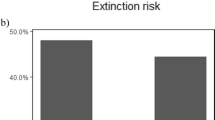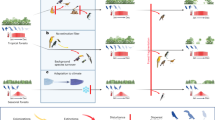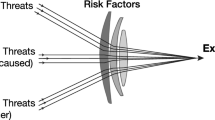Abstract
The tropics support some of the world’s richest centres of species diversity and endemism, yet these biomes are now dangerously imperilled by anthropogenic change. If we are to avert, or at least mitigate, catastrophic loss of species in these areas, it is vital to understand the direct and indirect effects of these agents of threat. Moreover, provision of a robust theoretical and empirical underpinning for the relationship between evolved characteristics (life-history traits and ecological preferences) and extinction risk may provide a general theory of extinction process that would be useful for conservation management. Birds provide some of the best quantitative data in tropical regions on the rate and selectivity of extinctions. Also, their autecology is better known than most other tropical taxonomic groups, making them ideal candidates for the application and testing of extinction theory and viability models. Using the relatively well-studied avifauna of the Australian tropics as an example, we apply population, habitat and threat data based on observed trends, in combination with various lines of surrogate information, to develop a predictive framework for extinction vulnerability of the region’s birds. Our inferences are based on generalized linear mixed modelling from an a priori set of models that include range, population, life history and threat variables. The best-selected model, with 92% of the AIC weight of evidence, was then used to rank the 387 species in terms of relative threat. We compare these results with predictions based on trends in habitat alone, and consider the likely impact of projected future threats during the twenty-first century.

Similar content being viewed by others
References
Ali A (1996) Vulnerability of Bangladesh to climate change and sea level rise through tropical cyclones and storm surges. Water Air Soil Pollut 92:171–179
Angermeier DA (1995) Ecological attributes of extinction-prone species: loss of freshwater fishes of Virginia. Conserv Biol 9:143–158
Beissinger SR, Walters JR, Catanzaro DG, Smith KG, Dunning JB Jr, Haig SM, Noon BR, Smith BM (2006) Modeling approaches in avian conservation and the role of field biologists. Ornithol Monogr 59
Barrett G, Silcocks A, Barry S, Cunningham R, Poulter R (2003) The new atlas of Australian birds. Birds Australia, Melbourne
Bennett P, Owens I (1997) Variation in extinction risk among birds: chance or evolutionary predisposition. Proc Roy Soc Lond Ser B 264:401–408
Blakers M, Davies SJJF, Reilly PN (1984) The atlas of Australian birds. RAOU & Melbourne University Press, Melbourne
Brereton JLG, Kikkawa J (1963) Diversity of avian species. Aust J Sci 26:12–14
Brook BW, Bradshaw CJA, Koh LP, Sodhi NS (2006a) Momentum drives the crash: mass extinction in the tropics. Biotropica 38:302–305
Brook BW, Traill LW, Bradshaw CJA (2006b) Minimum viable populations and global extinction risk are unrelated. Ecol Lett 9:375–382
Burnham KP, Anderson DR (2002) Model selection and multimodel inference: a practical information-theoretic approach, 2nd edn. Springer, New York
Dostine PL, Johnson GC, Franklin DC, Zhang Y, Hempel C (2001) Seasonal use of savanna landscapes by the Gouldian finch, Erythrura gouldiae, in the Yinberrie Hills area, Northern Territory. Wildl Res 28:445–458
Eliot I, Finlayson CM, Waterman P (1999) Predicted climate change, sea-level rise and wetland management in the Australian wet-dry tropics. Wetlands Ecol Manage 7:63–81
Fisher DO, Owens IPF (2004) The comparative method in conservation biology. Trends Ecol Evol 19:391–398
Garnett S (1992) The action plan for Australian birds. Australian National Parks and Wildlife Service, Canberra
Garnett ST, Clarkson JR, Felton A, Harrington GN, Freeman AND (2005) Habitat and diet of the Star Finch Neochmia ruficauda clarescens in the early wet season at Princess Charlotte Bay, Cape York Peninsula. Emu 105:81–85
Garnett ST, Crowley GM (1995) Feeding ecology of hooded parrots Psephotus dissimilis during the early wet season. Emu 95:54–61
Garnett ST, Crowley GM, Barrett G (2003) Birds. In: Sattler P (eds) National land and water resources audit. Department of Primary Industries and Energy, Canberra, pp 18–33
Garnett ST, Woinarski JCZ, Crowley GM, Kutt AS (2007) Biodiversity conservation in Australian tropical rangelands. In: du Toit JT, Kock R, Deutsch J (eds) Conservation of rangeland biodiversity. Blackwell, Oxford (in press)
Hampe A, Petit RJ (2005) Conserving diversity under climate change: the rear edge matters. Ecol Lett 8:461–467
Harte J, Blackburn T, Ostling A (2001) Self-similarity and the relationship between abundance and range size. Am Nat 157:374–386
Hawkins BA, Porter EE, Diniz JAF (2003) Productivity and history as predictors of the latitudinal diversity gradient of terrestrial birds. Ecology 84:1608–1623
Higgins PJ (1999) Handbook of Australian, New Zealand and Antarctic birds. Parrots to dollarbird, vol 4. Oxford University Press, Melbourne
Higgins PJ, Davies SJJF (1996) Handbook of Australian, New Zealand and Antarctic Birds. Snipe to pigeons, vol 3. Oxford University Press, Melbourne
Higgins PJ, Peter JM (2003) Handbook of Australian, New Zealand and Antarctic Birds. Pardalotes to shrike-thrushes, vol 6. Oxford University Press, Melbourne
Higgins PJ, Peter JM, Cowling SJ (2006) Handbook of Australian, New Zealand and Antarctic birds. Boatbill to starlings, vol 7. Oxford University Press, Melbourne
Higgins PJ, Peter JM, Steele WK (2001) Handbook of Australian, New Zealand and Antarctic Birds. Tyrant flycatchers to chats, vol 5. Oxford University Press, Melbourne
Hilbert DW, Ostendorf B, Hopkins MS (2001) Sensitivity of tropical forests to climate change in the humid tropics of north Queensland. Aust Ecol 26:590–603
Hopkins MS, Head J, Ash JE, Hewett RK, Graham AW (1996) Evidence of a holocene and continuing recent expansion of lowland rainforest in humid, tropical north Queensland. J Biogeogr 23:737–745
Hutchinson MF, McIntyre S, Hobbs RJ, Stein JL, Garnett ST, Kinloch J (2005) Integrating a global agro-climatic classification with bioregional boundaries in Australia. Glob Ecol Biogeogr 14:197–212
IUCN-CMP (2006) Unified classification of direct threats. Version 1.0
Keith DA, McCarthy MA, Regan H, Regan T, Bowles C, Drill C, Craig C, Pellow B, Burgman MA, Master LL, Ruckelshaus M, Mackenzie B, Andelman SJ, Wade PR (2004) Protocols for listing threatened species can forecast extinction. Ecol Lett 7:1101–1108
Kotiaho JS, Kaitala V, Kolmonen A, Paivinen J (2005) Predicting the risk of extinction from shared ecological characteristics. Proc Natl Acad Sci USA 102:1963–1967
Kolar CS, Lodge DM (2002) Ecological predictions and risk assessment of alien fishes in North America. Science 298:1233–1236
Marchant S, Higgins PJ (1991) Handbook of Australian, New Zealand and Antarctic birds. Ratites to ducks, vol 1. Oxford University Press, Melbourne
Marchant S, Higgins PJ (1994) Handbook of Australian, New Zealand and Antarctic birds. Raptors to lapwings, vol 2. Oxford University Press, Melbourne
National Tidal Centre (2006) The Australian baseline sea level monitoring project annual sea level data monitoring report July 2005–June 2006. Australian Bureau of Meteorology, Melbourne
Norris K, Harper N (2004) Extinction processes in hot spots of avian biodiversity and the targeting or pre-emptive conservation action. Proc Roy Soc Lond Ser B 271:123–130
O’Grady JJ, Reed DH, Brook BW, Frankham R (2004) What are the best correlates of predicted extinction risk? Biol Conserv 118:513–520
Orme CDL, Davies RG, Olson VA, Thomas GH, Ding T-S, Rasmussen PC, Ridgely RS, Stattersfield AJ, Bennett PM, Owens IPF, Blackburn TM, Gaston KJ (2006) Global patterns of geographic range size in birds. PLoS Biol 4:e208
Owens IPF, Bennett PM (2000) Ecological basis of extinction risk in birds: Habitat loss versus human persecution and introduced predators. Proc Natl Acad Sci USA 97:12144–12148
Phillimore AB, Freckleton RP, Orme CDL, Owens IPF (2006) Ecology predicts large-scale patterns of phylogenetic diversification in birds. Am Nat 168:220–229
Reed RN, Shine R (2002) Lying in wait for extinction: ecological correlates of conservation status among Australian elapid snakes. Conserv Biol 16:451–461
Rodrigues ASL, Akaya HR, Andelman SJ, Bakarr MI, Boitani L, Brooks TM, Chanson JS, Fishpool LDC, Da Fonseca GAB, Gaston KJ, Hoffmann M, Marquet PA, Pilgrim JD, Pressey RL, Schipper JAN, Sechrest WES, Stuart SN, Underhill LG, Waller RW, Watts Matthew EJ, Yan XIE (2004) Global gap analysis: priority regions for expanding the global protected-area network. BioScience 54:1092–1100
Sekercioglu CH, Daily GC, Ehrlich PR (2004) Ecosystem consequences of bird declines. Proc Natl Acad Sci USA 101:18042–18047
Sodhi NS, Koh LP, Brook BW, Ng PKL (2004) Southeast Asian biodiversity: an impending disaster. Trends Ecol Evol 19:654–660
Thomas CD, Cameron A, Green RE, Bakkenes M, Beaumont LJ, Collingham YC, Erasmus BFN, de Siqueira MF, Grainger A, Hannah L, Hughes L, Huntley B, van Jaarsveld AS, Midgley GF, Miles L, Ortega-Huerta MA, Peterson AT, Phillip OL, Williams SE (2004) Extinction risk from climate change. Nature 427:145–148
Williams SE, Bolitho EE, Fox S (2003) Climate change in Australian tropical rainforests: an impending environmental catastrophe. Proc Roy Soc Lond Ser B 270:1887–1892
Williams SE, Pearson RG (1997) Historical rainforest contractions, localised extinctions and patterns of vertebrate endemism in the rainforests of Australia’s wet tropics. Proc Roy Soc Lond Ser B 264:709–716
Winter JW, Bell FC, Pahl LI, Atherton RG (1987) Rainforest clearfelling in northeastern Australia. Proc Roy Soc Qld 98:41–57
Acknowledgments
We are grateful to John Woinarski, Richard Noske, Don Franklin, Brian Venables and Keith Fisher, who provided advice on the veracity of predicted change estimates, and to Navjot Sodhi and Kimberly Smith for organizing the IOC symposium on Avian conservation in the tropics. We also thank Daniel Pfenningwerth who voluntarily helped assemble data for the threat analysis.
Author information
Authors and Affiliations
Corresponding authors
Additional information
Communicated by F. Bairlein.
Rights and permissions
About this article
Cite this article
Garnett, S.T., Brook, B.W. Modelling to forestall extinction of Australian tropical birds. J Ornithol 148 (Suppl 2), 311–320 (2007). https://doi.org/10.1007/s10336-007-0202-9
Received:
Revised:
Accepted:
Published:
Issue Date:
DOI: https://doi.org/10.1007/s10336-007-0202-9




